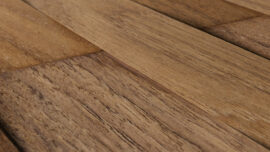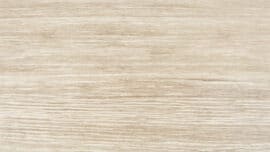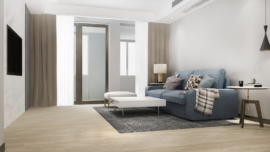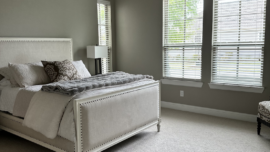
What is the Best Sunroom Flooring? Hardwood, Tile, or LVP?
When it comes to creating a beautiful and functional sunroom, choosing the right flooring is crucial. The flooring you select should not only enhance the aesthetics of the space but also withstand the unique challenges posed by sunlight, temperature fluctuations, and moisture.
In this blog, we will explore three popular flooring options for sunrooms: hardwood, tile, and Luxury Vinyl Plank (LVP). By examining the benefits, drawbacks, and considerations of each, you can make an informed decision about the best flooring for your sunroom.
Factors to Consider When Choosing Sunroom Flooring
Before diving into the specifics of each flooring option, it’s important to consider a few key factors that can influence your decision. These factors include:
- functionality and usage of your sunroom
- the amount of sunlight and temperature variations it experiences
- the moisture and humidity levels in the room
- the durability and maintenance requirements you’re willing to undertake
- your budget considerations
Exploring Hardwood Flooring for a Sunroom
Hardwood flooring exudes elegance and charm, making it a popular choice for sunrooms. It adds warmth and natural beauty to the space. However, hardwood does have some considerations when it comes to sunrooms. While hardwood is generally durable, prolonged exposure to sunlight can cause the wood to fade and change color over time.
Additionally, hardwood is susceptible to moisture damage, making it less ideal for sunrooms with higher humidity levels or prone to spills. However, by choosing engineered hardwood or opting for proper sealing and maintenance, you can mitigate these concerns and make hardwood a great option.
Pros of Hardwood Flooring in a Sunroom:
- Timeless and elegant aesthetic
- Adds warmth and natural beauty
- Can increase the value of your home
- Durable with proper care and maintenance
- Can be refinished to extend the lifespan
Cons of Hardwood Flooring in a Sunroom:
- Susceptible to fading and color change from sunlight exposure
- Prone to moisture damage if not properly sealed or maintained
- More expensive upfront cost compared to LVP or tile
- Requires periodic refinishing to maintain the appearance
Tile Flooring: A Viable Option for Sunrooms
Tile flooring offers a range of benefits that make it suitable for sunrooms. It is highly durable, resistant to moisture, and impervious to sunlight. Tiles come in various materials, such as ceramic, porcelain, and natural stone, allowing you to achieve different aesthetics. They also offer excellent temperature control, keeping the sunroom cool during hot summer days. However, tile can feel cold underfoot and may require additional heating or area rugs for comfort. The grout lines between tiles may also require regular cleaning and maintenance.
Pros of Tile Flooring in a Sunroom
- Highly durable and resistant to moisture, stains, and fading
- Wide range of design options with various colors, patterns, and textures
- Provides excellent temperature control, keeping the sunroom cool
- Easy to clean and maintain with regular sweeping and mopping
- Can be combined with radiant heating for added comfort
Cons of Tile Flooring in a Sunroom
- Can feel cold underfoot, especially in cooler weather
- Grout lines require regular cleaning and maintenance
- Hard and rigid surface may not be as comfortable to walk or stand on
- Installation can be more time-consuming and costly compared to LVP
LVP (Luxury Vinyl Plank) Flooring: A Modern Alternative
LVP has gained popularity as a versatile and cost-effective flooring option for sunrooms. It mimics the look of hardwood or stone but offers enhanced durability and water resistance. LVP is resistant to sunlight fading, making it a great choice for sunrooms with ample natural light. It is also softer and warmer underfoot compared to tile.
Additionally, LVP requires minimal maintenance, making it an attractive option for those seeking convenience. However, it’s important to select high-quality LVP with a thick wear layer for optimal performance.
Pros of LVP Flooring in a Sunroom
- Resistant to moisture, making it suitable for high-humidity environments
- Mimics the look of hardwood or tile at a more affordable price
- Durable and resistant to scratches, stains, and fading
- Low maintenance and easy to clean
- Softer and warmer underfoot compared to tile
Cons of LVP Flooring in a Sunroom
- Some lower-quality options may show signs of wear over time
- Limited design options compared to tile
- May have a synthetic feel compared to the authenticity of hardwood
Comparing the Options: Hardwood vs. Tile vs. LVP
To help you make an informed decision, let’s compare the three options based on key factors:
Durability and longevity: Tile and LVP flooring are highly durable and can withstand heavy foot traffic and potential sunroom hazards. Hardwood may require more maintenance and can be more susceptible to scratches and fading.
Resistance to moisture and sun damage: Tile and LVP are excellent choices for sunrooms with high moisture levels or direct sunlight exposure. Hardwood may require extra care and protection against moisture damage and sun fading.
Aesthetics and design options: Hardwood provides a classic, elegant look, while tile offers a wide range of design options with different colors, patterns, and textures. LVP can mimic the look of hardwood or tile and offers various styles and finishes.
Maintenance and cleaning requirements: Tile and LVP require minimal maintenance, while hardwood may need periodic refinishing and more careful cleaning to maintain its appearance.
Cost comparison and value for money: Hardwood tends to be the most expensive option, both in terms of material and installation costs. But the classic look is worth it!
Tile falls in the mid-range, with variations depending on the type of tile chosen.
LVP is generally the most budget-friendly option, but depending on your preferences, may not necessarily be the best choice.
Conclusion
Choosing the best flooring for your sunroom involves considering various factors such as functionality, sunlight exposure, moisture levels, durability, maintenance, and budget. While hardwood, tile, and LVP all have their advantages and drawbacks, the final decision depends on your specific needs and preferences.
If you prioritize a timeless and elegant aesthetic and are willing to take extra care to protect against sunlight and moisture, hardwood flooring is the ideal choice. For those seeking durability, resistance to moisture and sunlight, and a wide range of design options, tile flooring is an excellent option. If budget-friendliness, water resistance, low maintenance, and versatility are your priorities, LVP flooring may be the perfect fit.
When it’s time to transform your sunroom with the flooring of your choice, consider reaching out to GC Flooring Pros. Their team of experts can guide you through the selection process and provide professional installation services. Visit their website or contact them for all your sunroom flooring needs.
Remember, the best flooring for your sunroom is one that aligns with your specific requirements and brings both beauty and functionality to your space. Choose wisely and enjoy the sunlit oasis you’ve always dreamed of.
Sunroom Flooring FAQs
Will hardwood flooring in a sunroom fade over time?
Hardwood flooring in a sunroom can fade over time due to prolonged exposure to sunlight. However, choosing engineered hardwood or taking measures such as using window treatments or applying UV-protective coatings can help minimize fading.
Are tiles suitable for sunrooms with high humidity levels?
Yes, tiles are suitable for sunrooms with high humidity levels. They are resistant to moisture and offer excellent durability in such environments. However, proper installation and sealing are essential to ensure maximum protection against moisture.
Does LVP flooring require regular maintenance?
LVP flooring requires minimal maintenance compared to other options. It is highly resistant to stains, scratches, and fading. Regular sweeping and occasional damp mopping are usually sufficient to keep LVP flooring in great condition.
Can tile flooring feel cold in a sunroom?
Yes, tile flooring can feel cold underfoot, especially in cooler weather. To make the sunroom more comfortable, you can consider using area rugs or installing radiant heating systems beneath the tile flooring.
Is LVP flooring a cost-effective option for a sunroom?
Yes, LVP flooring is generally considered a cost-effective option for sunrooms. It provides excellent value for money due to its durability, resistance to moisture and fading, and low maintenance requirements.
Can hardwood flooring be installed directly in a sunroom without any special precautions?
It is advisable to take certain precautions when installing hardwood flooring in a sunroom. Ensuring proper subfloor preparation, using moisture barriers, and sealing the wood with appropriate finishes are essential to protect against moisture damage and sun fading.
Can tile flooring crack in a sunroom due to temperature fluctuations?
Properly installed tile flooring can withstand temperature fluctuations in a sunroom. However, it is crucial to use the appropriate type of tile and ensure a proper subfloor and underlayment to minimize the risk of cracking.
Which flooring option is the most durable for a sunroom?
Both tile and LVP flooring are highly durable options for sunrooms. They are resistant to scratches, stains, and fading. However, the specific durability depends on the quality of the materials chosen and proper installation.
Can I install any type of hardwood flooring in a sunroom?
Not all types of hardwood flooring are suitable for sunrooms. Certain hardwood species may be more prone to sun damage or moisture-related issues. It is best to consult with a flooring professional who can recommend the most appropriate hardwood options for sunroom installations.







